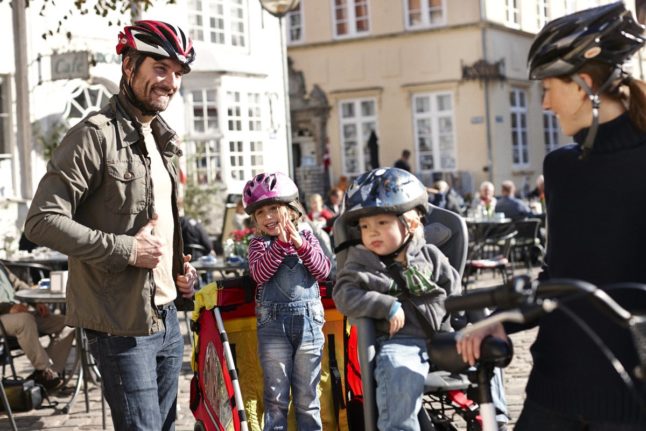Any non-native person learning Danish will have noticed that the numbers – particularly from 50 to 99 – follow a, let’s call it eclectic system.
I’ve been speaking Danish as a second language for well over ten years and my brain still protests whenever someone tells me their telephone number in two-digit clusters. It’s just not that easy to immediately understand and write each set down. (‘Did they say 67? 77? 76? I’m going to need to ask them to repeat it…’)
Even Norwegians and Swedes, whose languages have perfectly normal numbering systems, will readily admit to finding numbers baffling in their Scandinavian sister tongue.
In Danish, the numbers are more or less child’s play until you get to 50, but then things get a little weird.
Single digit numbers and teens follow a pattern you would expect to see if translating number names directly from English.
Twenty (tyve), thirty (tredive) and forty (fyrre) also have their own words in Danish, albeit with somewhat strange spellings.
READ ALSO: Five tips that make it easier to learn Danish
To say a number between 20 and 49, the process is again straightforward: for example, 25 is ‘five-and-twenty’ (femogtyve), 32 is ‘two-and-thirty’ (toogtredive) and 49 is ‘nine-and-forty’ (niogfyrre).
Easy, right? It’s about to become less so.
The common names for numbers 50 (halvtreds), 60 (tres), 70 (halvfjerds), 80 (firs) and 90 (halvfems) are actually shortened versions of even longer number names: halvtredsindstyve, tresindstyve, halvfjerdsindstyve, firsindstyve and halvfemsindstyve.
All of these names have the suffix sindstyve, which comes from the archaic sinde meaning ‘to multiply’, and tyve (20). So the names of each of these numbers come from another number name ‘multiplied by 20’. Most people would think it’s easier to multiply by 10 than by 20, but you do you, Denmark.
We now need to explain where the first half of these number names comes from. This is where it gets flat-out bonkers.
You may have noticed that 50 (halvtreds), 70 (halvfjerds) and 90 (halvfems) each have a prefix as well as the aforementioned suffix. That is to say, they all begin with halv, the Danish word for ‘half’.
But the halv in each of these three cases does not mean the same thing. It is itself abbreviated from other, different words which all begin with halv: a series of old-fashioned Danish words for fractions which literally mean ‘this number minus a half’.
One of these words is still in use in modern Danish: halvanden, meaning one-and-a-half, is a very useful word in itself. It’s quite easy to see that halvanden comes from ‘two minus a half’, since anden means ‘second’ and halv, as we know, means ‘half’.
Still with me? Ok, on we go.
As mentioned, halvanden is one of a family of words for fractions, but the only one still commonly used. The full set is as follows:
- halvanden: 1½ (literally, ‘the second minus a half’)
- halvtredje: 2½ (‘the third minus a half’)
- halvfjerde: 3½ (‘the fourth minus a half’)
- halvfemte: 4½ (‘the fifth minus a half’)
Clear as crystal? I hope so. Because now we’re leaving this diversion and going back to our multiples of ten from 50-90.
- 50, halvtreds, is constructed of halvtredje and sindstyve: 2½ times 20 equals 50.
- 60, tres, is the more simple tre (three) and sindstyve: 3 times 20 equals 60.
- 70, halvfjerds, is constructed of halvfjerde and sindstyve: 3½ times 20 equals 70.
- 80, firs, is the more simple fire (four) and sindstyve: 4 times 20 equals 80.
- 90, halvfems, is constructed of halvfemte and sindstyve: 4½ times 20 equals 90.
From here, the rest of the numbers between 50-99 are plain sailing, since they are spoken the same way as the lower double-figures. So 55 is ‘five-and-fifty’ (femoghalvtreds), 82 is ‘two-and-eighty’ (toogfirs) and 99 is ‘nine-and-ninety’ (nioghalvfems).
I suppose we could say that when you say a number like 55, you are technically saying ‘five-plus-two-and-a-half-times-twenty’… but let’s leave that for now.
So now the logic behind Denmark’s counting system is fully explained, right? Well, not quite, because there’s a dark horse: the number 40.
Earlier, I wrote that the word for 40 in Danish, fyrre, just means 40. But that’s not exactly correct. It’s actually an abbreviation of fyrretyve.
Fear not though, for this time there are no multiples of 20 involved. Fyrretyve comes from the Middle Danish word fyritiughu, which can be translated to ‘four tenners’. Someone, somewhere in Danish history, apparently did see the sense in using multiples of 10 after all.



 Please whitelist us to continue reading.
Please whitelist us to continue reading.
Finally I understand! 😀 Well explained.